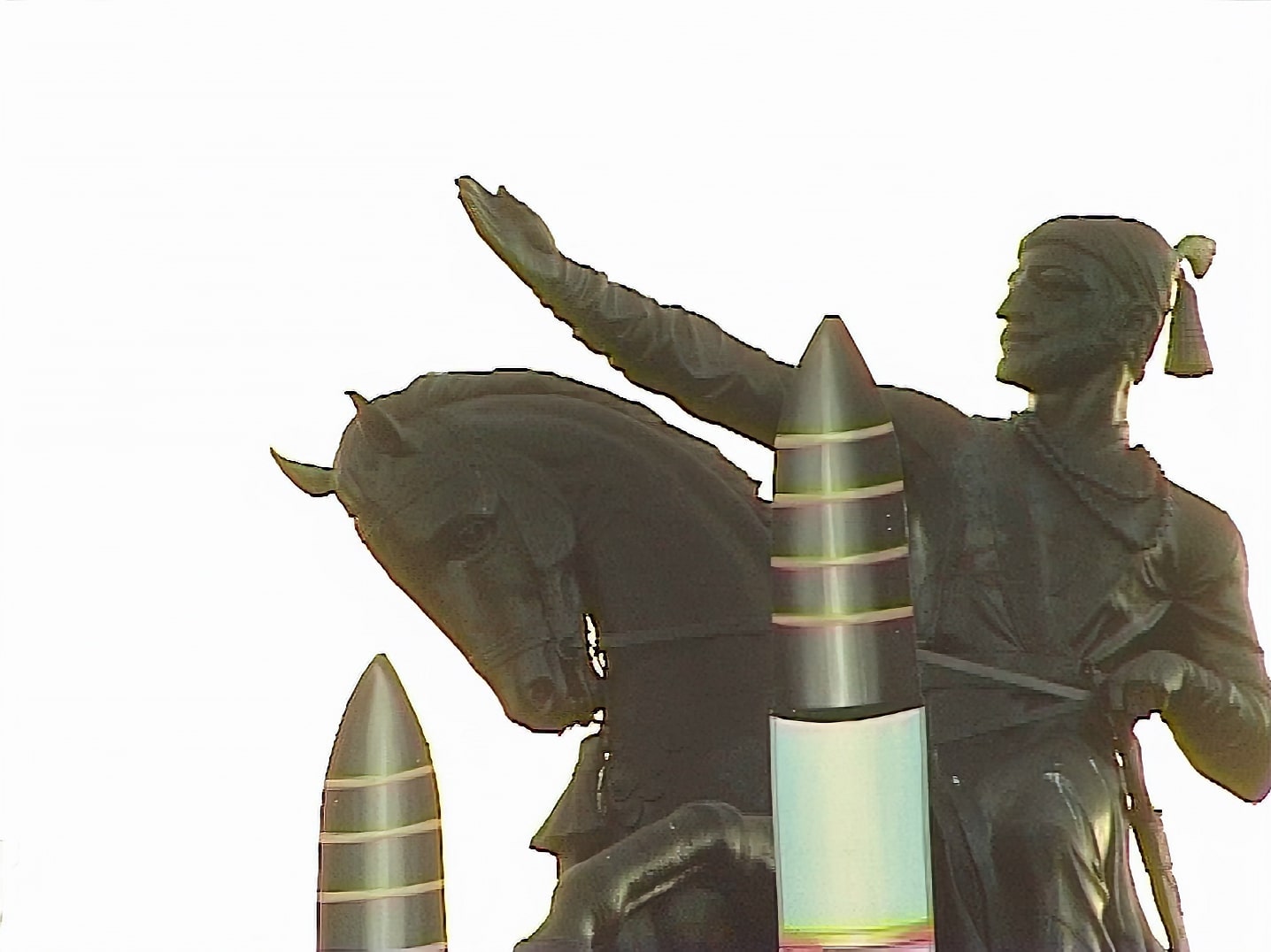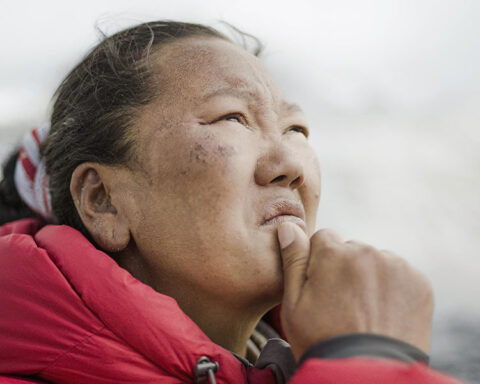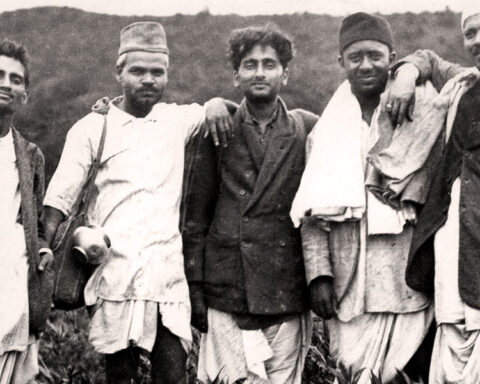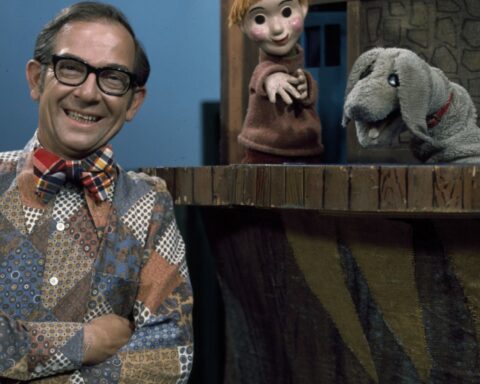Anand Patwardhan has been called in the U.S. the “Michael Moore of Indian documentaries,” a quick-hit description of a dedicated artist and activist who has been making politically charged documentaries for nearly three decades. Over that time, the Mumbai filmmaker has tackled subjects like street dwellers, religious fundamentalism, the connection between machismo and sectarian violence, and the plight of those displaced in the name of “development.” His films, which have won awards from Mannheim to Yamagata, include Bombay Our City (1985), In Memory of Friends (1990), In the Name of God (1992), Father, Son and Holy War (1995), A Narmada Diary (1996) and his latest, War and Peace (2002).
Of War and Peace, which Nandini Ramnath in Time Out Mumbai called a “rousing, engrossing and unexpectedly funny broadside against India’s hot chase of the (nuclear) bomb,” Elvis Mitchell in the New York Times praised its “riveting intelligence,” while Duncan Campbell in the UK’s Guardian called it “a tour de force.” Like all of Patwardhan’s major films, it has run into censorship issues in India with the director having to take the CBFC (Central Board for Film Certification) to court in order for it to be screened in his home country. Since the film’s release, Patwardhan has made local language versions and attempted to get it and earlier films broadcast on Indian TV.
Anand Patwardhan got his MA in Communications at McGill University and directed an award-winning film A Time to Rise (1981), about immigration and labour politics, while living in Canada. Veteran documentary filmmaker Magnus Isaacson interviewed Patwardhan in Montreal for POV.
POV: Documentary filmmakers, like a lot of cultural workers, are involved in some kind of resistance, some kind of a struggle, but I imagine that being where you are located in the world, there is an even greater sense of urgency. What’s the difference between making films in Montreal and in India?
AP: First of all, when I was in Montreal initially, it was really an exile. An Emergency had been declared in India in which thousands of political opponents of Indira Gandhi were jailed and the press curbed, and Waves of Revolution, a documentary I had made, went underground. I smuggled out a copy by cutting it into small reels and sent these to Canada with several travellers. I then got admission to do an MA at McGill and spent two years piecing the film together and showing it all over North America to raise public opinion against the Emergency. I returned to India when the Emergency ended but came back to finish my degree in 1979 and stayed till 1982. During this period I made A Time to Rise. So I ended up spending five years in Montreal in all, and loved it. It is like a second home to me.
There are big differences. Here, here’s much more of a support system for filmmakers. The National Film Board was very open to helping independent filmmakers like me. I don’t know if it’s the same today. I found it important to be here at the time. Though now there is an increasing tribe doing documentaries in India, in those days there wasn’t. That’s the negative side. The positive side is that in India you always feel an immediate urgency for the work that you’re doing. You know that as soon as you finish your film, it’s going to be useful. You can start showing it right away, at least in activist circles. Canadian filmmakers often make films outside Canada because they don’t find the immediacy to make films about issues over here. Perhaps they’re not necessarily life and death issues in the same way.
POV: In your latest documentary feature War and Peace, you situate yourself right at the beginning of the film.
AP: I had never actually done a first person narrative before. It was a tactical decision. I knew that I would be targeted for not being a patriot. I was attacking India’s nuclear bomb and “nationalism” and so decided to foreground my family background in order to deflect criticism. I started out by stating that my uncles went to jail for many years for fighting against British rule, so that I could establish my “patriotic” credentials. The first person, of course, also gave me license to say things, which in an impersonal narrative would have been difficult to say.
POV: Do you think that might lead you to having more personal elements in your films?
AP: I don’t think I’ll end up doing confessional documentaries but I might use the first person narrative again sometime because yeah, you get poetic license. You’re not forced to be totally balanced about everything. All my films are from my point of view. They’re not pretending to be objective, but working in the first person gives you even greater freedom.
POV: There is quite an ongoing discussion here about those kinds of issues: self-reflexivity, aesthetics, modes of storytelling. Do you think that is something that Canadians can afford to do more of, because we live in a relatively more privileged position?
AP: No, actually, if you look at Indian documentary films made recently, many people are obviously concerned about the formal structure and worry about theoretical aspects. Personally, I’m not really patient with too much theory. It doesn’t excite me. You can be self-reflexive, but ultimately it’s an artificial device. If I show my camera or my microphone in my frame, it doesn’t absolve me from the act of filmmaking. No matter what you do to announce that you’re being self-reflexive, you still maintain control in the act of filmmaking: you’re doing the editing, you’re doing so many things which give you complete control over what you’re saying. It’s not necessary to treat the audience like idiots and say, ‘I am making a film, and this is the film, it’s not real.’ Take it for granted, the audience knows.
POV: You made a very interesting film, Father, Son and Holy War about machismo, about the male psyche and how it relates to politics and religion. You could have included yourself, your own upbringing, your own training…
AP: I wasn’t making a film about gender to start with; I was actually making a film about religious and communal violence, the things that I saw around me, mainly the Hindu-Muslim violence that had broken out. But as I explored these issues in greater depth, I found the connection between the male psyche and this violence, so I started filming and thinking along those lines, and that’s the shape that the film took.
By the ’80s, everybody who was politically active, or was interested in trying to improve conditions, was totally sidetracked by the rise of fundamentalism, at least in our part of the world. I saw that even trade unions were becoming communalized. I couldn’t show In the Name of God in union halls because the leadership told me that if I showed a film targeting Hindu fundamentalists, workers would turn against us. That was a great disappointment. I could no longer really talk about class issues alone. I began looking at psychology, at where this crazy impetus for religious hatred was coming from. Father, Son and Holy War is an attempt to look at the psyche of violence, not assuming like the Left did at the time, that if you’re working-class, you’ll automatically come to the truth. At the same time, I didn’t find room to get into my own personal psyche. That would have been a different film altogether, not invalid, but it may have deflected from the depiction of the external horror I was documenting. This horror did not care who the particular witness was. I felt it was the “eye” and not “I” that was important at the time.
POV: And do you think that you would have come to that analysis if you had not spent several years in this part of the world, confronted with the feminist movement, the student movement and so on?
AP: Oh, in India these issues are discussed probably even more than over here, at least in middle and upper middleclass circles and in colleges. But maybe ten years prior to that, I wouldn’t have come to this analysis. It was something that came globally, out of the ’70s and ’80s.
I had actually begun to make films against religious fundamentalism in the mid ’80s, after the massacre of Sikhs in Delhi in 1984, when Indira Gandhi was killed by her Sikh bodyguards. In revenge, over 3000 Sikhs were killed within three days. That’s when I dropped other things that I was doing and started making films against fundamentalism and religious violence. The next ten years I kept shooting in different parts of the country and three films came out of that footage. The first, In Memory of Friends, was about the Sikh-Hindu divide. The next, In the Name of God, was about the Babri Mosque being demolished in north India by Hindu militants, and the last one was Father, Son and Holy War.
In a sense, the first film was a more traditionally Marxist analysis about how class struggle would be the antidote to religious violence—if the working-class could only get together, they would forget their religious differences. But the second of those films looked not only at class issues, but also talked about caste, and about liberation theology, because I found a Hindu priest who actually said, ‘this is not Hinduism; my Hinduism doesn’t teach this kind of violence or hatred.’ He was murdered later, and became one of the main protagonists of the film. In the Name of God tried to identify and unite different forces that would help build a healthier, more secular polity. It included the left approach, but also other approaches. And Father, Son and Holy War got into gender, so these three films together form slightly different prisms through which religious fundamentalism can be viewed.
POV: Often the idea of the good working man or woman fighting the oppressors is associated with a very optimistic view of human nature. When you start looking into jingoism and nationalism gone wild, religious warfare, and all these kinds of sectarian struggles, does it change your view of human nature?
AP: Well, it doesn’t really change my overall perspective. Human nature isn’t either good or evil. I know that working-class people were also communalized, but they weren’t the authors of that communalism or fundamentalism. They were obviously being manipulated. In a much broader sense, you can still use traditional class analysis, and see how people are being misled. But my films are not ideological or theoretical. I actually construct them after I’ve shot and looked at footage over the years on an editing table, seeing what the material is saying. Since I’m documenting real events there might be lots of inconsistencies. There’s no simple or single trajectory that the films take.
POV: I think part of what we are up against as documentary filmmakers is the worldwide control of information, the filtering of information. Do you see it as some kind of a global conspiracy? Do you see it as a network of power relationships? Where do you think it stems from?
AP: I never believed too much in conspiracy theories, but you keep coming across stuff that makes you think that there is a conspiracy of some kind, and some of our most paranoid fears were not absolutely wrong. There are so many blind spots in the world’s common knowledge of historical events. Once you do a little bit of research—I’m amazed at things that I come across. If you look at the history of Iraq for instance, how the super powers have been trying to control that oil for decades, the British did it before the Americans. The entire globe has been divided for its resources. So I don’t think this could be a complete accident.
POV: You’ve been involved in a lot of fights for freedom of speech, for the right to have your films shown. I am almost surprised to hear you say that you have had quite a bit of success in India.
AP: Yeah. I have to give credit to the Indian democratic system at times. Though I don’t think that you could extrapolate that we live in a democracy because people like me have had their rights; if I were working-class and not privileged, I’m sure that that wouldn’t be true. But in the position that I am, I have been able to use my democratic rights in India, and as a filmmaker, certainly. The government has attempted to censor my films every time, but in the last 35 years of filmmaking, I’ve won every single one of those battles in the end and not a single frame has ever been cut.
POV: Although the censors have demanded the most ridiculous and extensive cuts in some of your films.
AP: Right up to the mid ’90s and Father, Son and Holy War [the film made prior to War and Peace] you can characterize government intervention as a kind of comedy of errors, where the Censor Board was intervening in a very stupid and arbitrary way. I would expose how silly and hilarious they were being in the press, fight the matter within the ambit of the Censor board and eventually get my way without going to court. But with War and Peace —by this time the BJP [Bharatiya Janata Party] had come to power —it was no longer just bumbling and bureaucracy that was causing the cuts. This was an ideologically right-wing government that had taken a decision not to allow any secular films of this nature through at any cost.
POV: You’ve said that inevitably as documentary filmmakers we’re involved in voyeurism: in a certain sense, taking advantage of our subjects.
AP: What I meant about voyeurism was that most of the films that I’ve made have been about injustices, about other people’s misery, and you have to ask yourself about your right to entry at every moment when you’re filming. That’s something for which there’s no clear-cut answer. The only way that I can do it is to convince myself at the time that, yes, this is worth doing because I’m going to be able to give something back to the people whose privacy I’ve just invaded. That’s of course not true for all the people that I film. Because in my films obviously there are the good guys and the bad guys, and I don’t have that same sense of responsibility to the people whom I consider to be consciously part of the problem. For instance I’m not, in the same way, motivated to go and show my film personally to the career-minded nuclear scientists who lie on record that there are no cases of cancer caused by their nuclear program.
POV: But even the people who are on the “right side” of the fence, there is a question about how you portray them…[Our] responsibility is not just to the people who we’re filming, but also to the movements who are trying to learn something from that fight, to the people who are going to use the film, and to a certain kind of truth. And sometimes portraying people with warts and all, with their contradictions, and their difficulties, and sometimes their weaknesses or their faults, I think is both more true to reality, and in the end, a more useful lesson for the social, political movements.
AP: I think that’s right. Obviously everybody has all kinds of sides to their being, and what you’re getting from the camera are only a few sides…
POV: But there are people who would film several sides but when they get to the cutting room, they idealize their subjects or build them up to some kind of heroes.
AP: Yeah.
POV: ’Cause most of the people in your films look strong and determined, and you feel that they’re fighting the good fight.
AP: So you think that I might have edited out the not-so-positive parts?
POV: No, I just wonder how you feel about it…
AP: I think maybe what you’re pointing out is that, in a sense, when an artist does a portrait, they highlight parts; a portrait is not exactly a photograph, it is the artist’s impression. They might have a bigger nose in the sketch than actually exists in real life. What you get in a documentary portrait is a similar process where certain characteristics get highlighted, because those are the ones that strike me the most. If the strength of a person strikes me the most, my film will reflect that.
POV: I feel that I’m constantly, in following social movements and their struggles, living with a tremendous tension between representation on the one hand and good dramatic filmmaking on the other. A lot of choices have to be made along the road. I remember in the film about the Cree fighting a Hydro project in northern Quebec, a film called Power, there were many, many individuals standing up criticizing their own Band leadership. In the end, there were too many faces appearing on the screen, and we decided to let one of those people be the spokesperson for that opinion. That’s, of course, a tremendous simplification, and some people didn’t really approve, but it certainly worked better for the film.
AP: Yeah. Many times I’ve been told that my films would probably be more dramatic or work better if I didn’t have so many people in the film, if I followed the story of one person or one family, and just see where that takes me. But what I set out to do was to document movements and inter-related events. Had I restricted myself to one person, it would certainly have emotional weight, but it could also be reduced to being the story of just one person. I have always wanted to tell a larger story. I haven’t thought this out very clearly; it’s not that I’ll never do a single person film in the future. But yeah, most of the time it hasn’t been like that. At the same time, there are individuals like Pritam Kaur in A Time to Rise or the priest Pujari Laldas in In the Name of God who are very charismatic. Sometimes people, even in the short time that you see them, leave a big impression on you in the end.
POV: You worked on A Narmada Diary, about a struggle that went on for years. When you make that into a one- or two-hour film, you’re excluding various parts of the story, parts of the community. You don’t feel there is that tension between representation and filmmaking. . . because you have to make choices for the film?
AP: In a sense that’s why we ended up calling it a “diary.” The two of us who made the film, Simantini Dhuru and myself, visited the valley over five years, so we got brief glimpses into the movement over a period of time. We couldn’t really claim that we had documented the whole movement. That is probably true of all the films…
POV: I used to be very interested in international subjects and when I worked as a television producer, was travelling to different continents, but in the end, the reason that I am shooting closer to home is that I love following things very closely for a couple of years.
AP: I have shot close to home a lot. Bombay, Our City is shot exclusively in Bombay. A lot of Father, Son and Holy War was shot there too—the parts to do with the riots in Bombay. So was a part of In the Name of God. Many of the films got made because I happened to have a camera ready and things were happening which were immediate and nearby and so I went out and filmed.
POV: Would you ever consider giving the subjects of the film any kind of editorial control or input in the editing and the structuring of the film?
AP: Editorial input, certainly. Before a film is done, and even at an earlier stage, there is a lot of interaction with the people that I am close to in the movements that I am working with. But editorial control, I only give this up in cases where a film has to be used for a specific purpose because it’s something that can be immediately useful. Like a few months ago, there was a big demonstration of slum-dwellers where we were attacked by the police. I was also attacked and my camera was damaged, but I did get some footage out. We used that immediately and showed it to the press. These are times when the use of film material is totally dictated by the immediate needs of the Movement. But otherwise, editing I do myself, because that’s really where the film is conceptualized and put together in the end.
POV: I’ve noticed at film festivals that a lot of the important films about situations in southern or third world countries are made by people who have moved to Paris or London or Amsterdam and become film students; then they go back to their countries of origin to make films. How do you see that?
AP: I guess it’s to do with sources of funding. Money becomes available to people who have moved. It’s fair enough and it depends on the film. There is one danger though: if they don’t have an audience at home in mind at all, then they make it in a particular way which may not be accessible to the people they filmed. I would like to see a film made on India, be useful in India as well. I don’t enjoy seeing films, which are clearly made for consumption by Northern audiences alone. Of course the exception to this are films made by the Indian Diaspora, which specifically address the diasporic experience, or are made about the countries of adoption. Basically I believe that those who are filmed should also be a part of the imagined audience.












